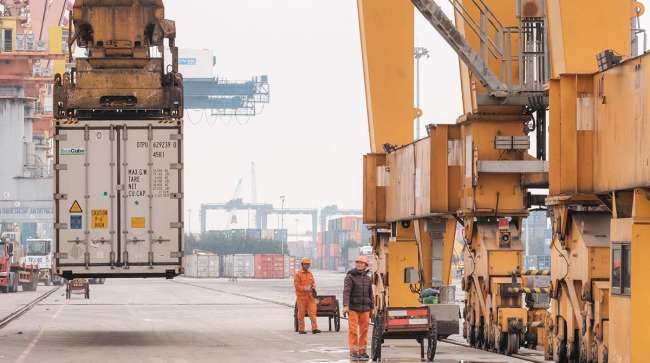Handelsavtal och strävan efter rättvisa
Nya regler hamnar i rampljuset i takt med att livet fortsätter att utvecklas kring global handel. De senaste handelsavtalen som ingåtts syftar till att stävja metoder som har tillåtit vissa länder att undgå tullar, inklusive att flytta produktionsprocesser till andra nationer. Detta har viktiga implikationer för logistik och sjöfartsindustrin.
Juridiska kryphål som åtgärdas
I hjärtat av dessa nya handelsavtal finns en robust dialog om de juridiska metoder som har tillåtit produkter att kringgå tullar. Mer specifikt är fokus på ursprungstvättDetta innebär att produkter omdirigeras genom andra länder och presenteras som lokala varor, vilket försvårar efterlevnad och övervakning av tullar.
| Handelsavtalsfunktioner | Effekter på logistik |
|---|---|
| 20%-tariff på specifik export | Ökade kostnader kan förskjuta transportrutter |
| 40%-tariff på varor som omlastas via tredje land | Mer granskning leder till längre leveranstider |
Oväntade konsekvenser och den svårfångade balansen
Vissa länder, särskilt i Sydostasien, har sett en ökning av verksamheten eftersom företag från andra länder, särskilt Kina, har sökt nya platser för att kringgå tullar. Detta har lett till en mängd aktiviteter från fabriksuppsättningar till logistiska justeringar. När dessa företag sprider sig över Sydostasien blir varuflödet från platser som Vietnam alltmer sammanflätat med Kinas operativa metoder.
En alarmerande trend har observerats; medan tullarna syftar till att stödja lokala industrier, höjer de effektivt priserna för konsumenter i hemländerna. Detta har potential att generera spridningseffekter i hela logistikindustrin, vilket påverkar allt från fraktpriser till leveranstider.
Ökningen av sjöfartsverksamheten i Sydostasien
Tillverkningslandskapet är inte längre statiskt. Varor som en gång i tiden enbart tillverkades i ett land monteras nu ofta på flera platser, vilket kan fördunkla data över handelsflöden. När produkter skeppas från fabriker i Sydostasien – byggda med kinesiska delar – blir orsak-och-verkan-förhållandet i logistiknätverket ganska komplext.
Branschexperter har uttalat sig om den internationella sjöfartens utveckling mitt under dessa händelser. Enligt vissa ekonomer, om tullarna behåller ett smalt fokus och är välriktade, kan effekterna vara hanterbara. Annars riskerar en bred ansats att skada inte bara de avsedda målen, utan även logistikföretag globalt.
Att lära av tidigare erfarenheter
Med tanke på den ökande komplexiteten inom logistik ger analysen av hur tidigare handelsbestämmelser har påverkat sjöfarten värdefulla insikter. Ett exempel är hur en föreslagen 40% importskatt på varor skulle kunna utnyttja mindre kompatibla metoder, vilket leder till att företag pressar sina produkter genom mindre reglerade marknader – vilket potentiellt skapar ännu djupare utmaningar när det gäller att upprätthålla transparent logistik och transportkanaler.
Nya regler: Ett tveeggat svärd
Det är viktigt att notera att själva de regler som är avsedda att skapa rättvisa förutsättningar kan leda till oavsiktliga konsekvenser. Den ständigt närvarande faran är att regelverk kan kväva logistikeffektiviteten. Till exempel kan ytterligare pappersarbete och granskning från tillsynsmyndigheter fördröja fraktprocessen avsevärt. Experter har rapporterat att exportprocessen i flera länder har fördubblats i tid, vilket har fått många att ompröva sina transportstrategier.
Regleringsjusteringar över gränserna
Olika länder har börjat centralisera processer för att bättre hantera efterlevnad. Till exempel har vissa länder börjat utfärda ursprungsintyg mer strikt, vilket gör det till en mer involverad uppgift för exportörer att bevisa legitimiteten i sina produktionsprocesser. Fördelen? Ökat förtroende för produktresan, vilket potentiellt leder till en mer pålitlig leveranskedja. Nackdelen kan dock vara längre ledtider och förändrade logistikramar.
Summerar utvecklingen
Att navigera genom dessa förändringar innebär både utmaningar och möjligheter för logistikbranschen. I takt med att handelslandskapet förändras måste logistikproffs anpassa sig till ökad granskning och regelverk. Men förändring medför ofta nya möjligheter till operativa förbättringar. Att känna igen viktiga andelar av handelsflöden, förstå tariffernas konsekvenser och anpassa verksamheten till efterlevnad kan avsevärt förbättra ett företags logistikstrategi.
Betydelsen av personlig erfarenhet
Medan denna översikt av den pågående handelsdynamiken ger en grundlig analys, kommunicerar ingenting den fulla effekten lika bra som personlig erfarenhet. Att ha förmågan att dra nytta av förstahandsinteraktioner med lasttransporter gör att logistikproffs bättre kan navigera i dessa stormiga vatten. Plattformar som GetTransport.com erbjuder fördelen att enkelt kunna beställa lasttransporttjänster till konkurrenskraftiga priser globalt, vilket möjliggör välgrundade beslut utan onödiga kostnader eller obehagliga överraskningar.
Lika betydelsefulla som dessa utvecklingar är för global logistik, bör du betrakta dem som en uppmaning att anpassa dina fraktstrategier för att förbli smidig i en varierande miljö. För alla dina transportbehov, oavsett om det gäller frakt av skrymmande gods eller att säkerställa konsekvent leverans, står GetTransport.com redo att effektivisera dina logistikprocesser, förse dig med de bästa erbjudandena och hjälpa dig att transportera dina varor smidigt. Varför vänta? Boka nu!

 Undersökning av nya handelsavtals inverkan på logistik och sjöfart">
Undersökning av nya handelsavtals inverkan på logistik och sjöfart">